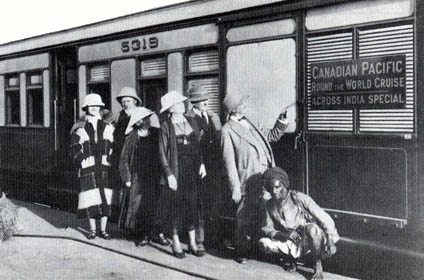Vol. 17 No. 11
November, 1987
|
Stay Safe in 87
|
|

"The World's
Greatest
Travel System"
|

Dave Jones
|

In the years between the two world wars,
Canadian Pacific became very adept at moving people as well as freight, whether by land or by sea. So adept in fact,
that the company's trademark slogan, "The World's Greatest Travel System", was accepted by the public as
self-evident, rather than a slick piece of advertising copy.
After all, several generations of Canadians had grown up with the company and had come to expect a quality of
service which didn't neglect the little niceties that made a trip not just comfortable, but memorable.
But the expertise of Canadian Pacific's cruise department was taxed to the limit in providing world cruise passengers
with the necessary transportation arrangements to make shore leave a thing to write home about.
In many of the ports-of-call tenders were required to transport the passengers from the ship's offshore
anchorage to the shallow waters at dockside.
At Bombay, tenders left the Empress steamships every half hour for sightseeing excursions on the Indian mainland,
while the Yangtze River was often so crowded that the ships anchored at Woosung and passengers were ferried up to
Shanghai, passing everything from Chinese junks to British and Russian cruisers.
The tenders were simple craft, resembling open-topped military landing craft, but they were more than
adequate for their purpose and provided a splendid view of many a busy waterfront.
Occasionally river steamers were chartered, as was the case on the Nile River, where the renowned travel agency
Thomas Cook & Sons operated charming vessels complete with decorative awning protecting the passengers from the
glare of the desert sun.
Railway excursions, of course, were an absolute must for inland journeys to the Taj Mahal at Agra in India, or to
Peiping in China.
The best equipment was sought out in each country, and sometimes resulted in a configuration of coaches quite unknown
in regular service.
In 1934, a 20-car train assembled in China for the use of passengers from Canadian Pacific's flagship,
Empress of Britain, was the longest that had ever operated in that country at that time.
In Medeira, a mountain railway was used to climb the 1,000 metres to picturesque Terreiro da Lucta, while the trip
down the mountain could be negotiated in wicker sledges with runners, which were guided along by native attendants
with the aid of a rope on either side.
From Hong Kong to Canton, passengers could avail themselves of either a steamship or a train ride, as both were
normally provided for by the company.
MAN-POWERED CARTS INTRIGUE TRAVELLERS
The orient, in particular, provided a number of novel forms of conveyance. In Ceylon, rickshaws were hired to give
rides along the ubiquitous rice paddies, and in Peking and Singapore, the demand for the two-wheeled
man-powered carts was so great that often as many as 500 would be readied for the arrival of the
Empresses.
Passengers were often so intrigued by the vehicles that they exchanged places with the young men pulling them, much
to the delight of the willing entrepreneur.
For the ladies, a lift in a sedan chair up the mountain in Hong Kong was only a matter of asking a Canadian Pacific
representative for it to be arranged.
For the more adventuresome, who desired to get off and explore on their own, cars by the fleet were awaiting their
use at Monte Carlo, while 150 cars were readied on the quay at Algiers, each one numbered and carrying a Canadian
Pacific house flag.
In Bermuda, bicycles were made available, and were usually in great demand from the time the gang-planks
were lowered.
And, not to be forgotten, were the trips from Cairo to the pyramids by camel for the men and by
sand-cart or donkey for the women.
Even the demanding climb up the great pyramid of Cheops was aided by several strong guides provided for by the
company.
One passenger explained that "to do this comfortably you want four Arabs - two to pull from above and two to
boost from below, but even then it is too strenuous to be attractive".
It's no wonder that the company's claim to be the world's greatest travel system received so little argument. Where
else were so many modes of transportation available to the public under one management?
This CP Rail News article is copyright
1987 by the Canadian Pacific Railway and is reprinted here with
their permission. All photographs, logos, and trademarks are the property of the Canadian Pacific Railway
Company.
|